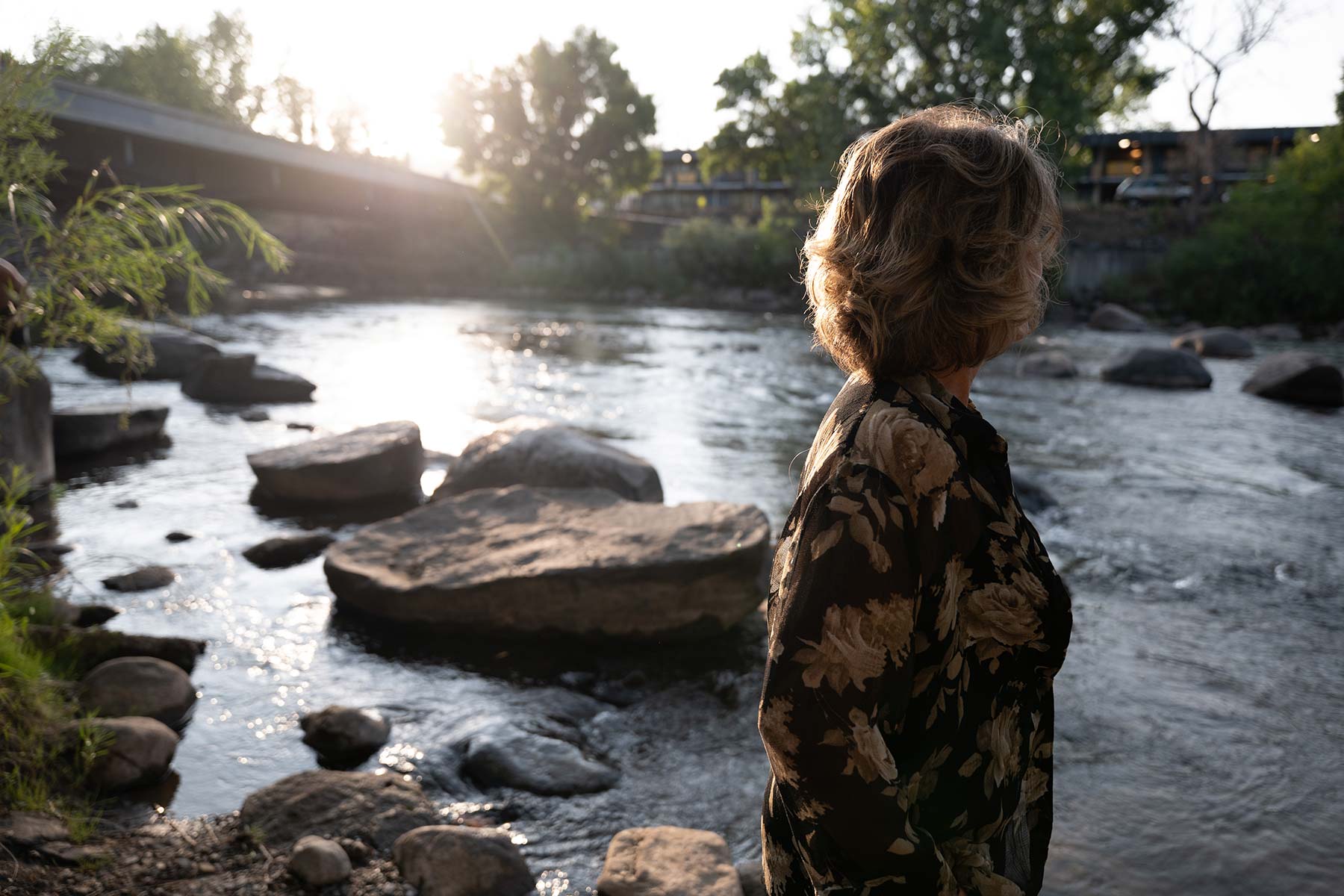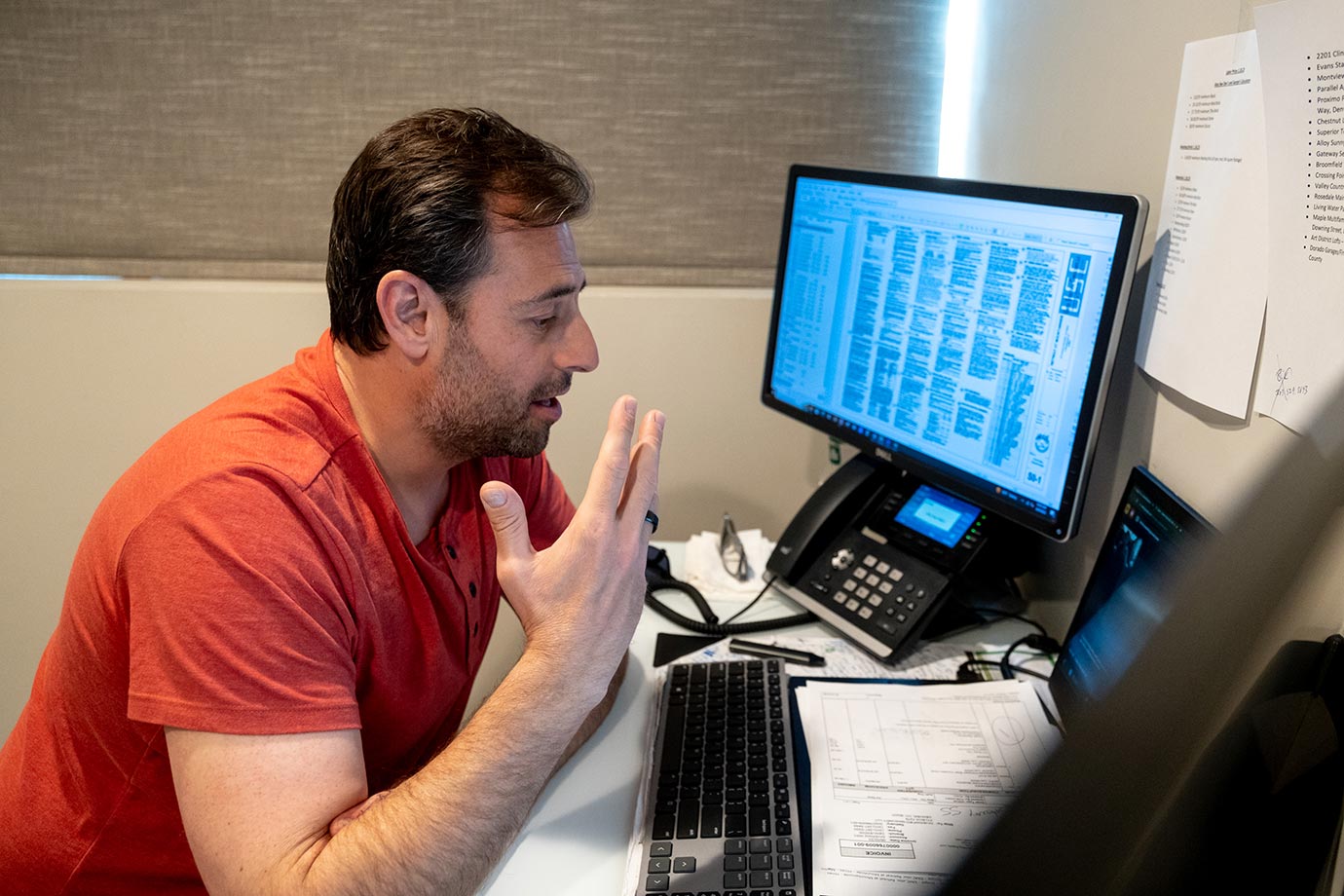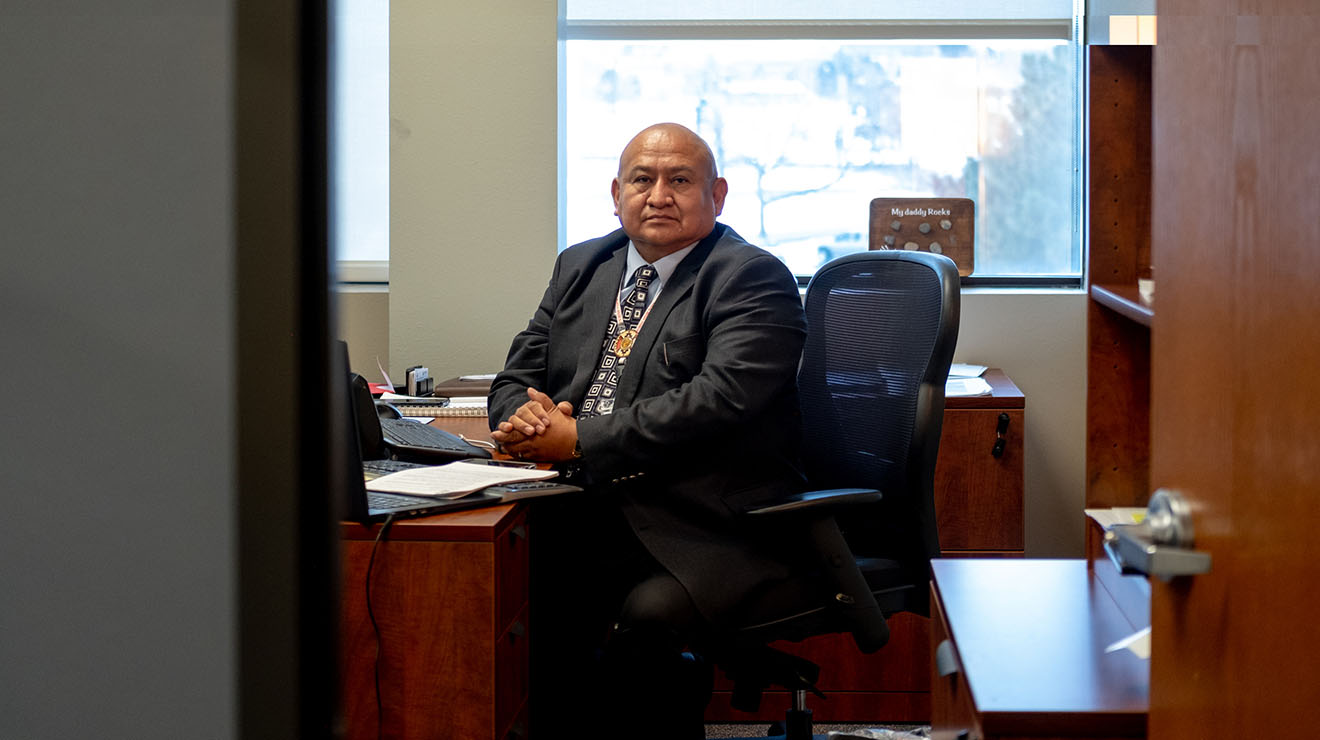It had been more than 24 hours since Laura last heard from her son Andrew. The 30-year-old, who had been diagnosed with schizophrenia years earlier, was living on his own and chose not to take medication regularly or attend therapy. His family respected his desire for some independence, but they also agreed that they would show up at Andrew’s Durango apartment if they went more than a day without talking to or seeing him. (Laura requested to only use their first names to protect her son’s privacy.)
After repeated phone calls and knocks on Andrew’s front door were ignored, which was unusual, Laura decided to call in reinforcements for a welfare check. Though he’s never been a danger to others, Andrew sometimes struggles to concentrate or forgets to take care of himself—once, in a paranoid state in the middle of winter, he threw his portable heater outside—and his mother was concerned about his well-being.
But instead of law enforcement, Laura contacted CORE, Durango’s co-responder program that launched in 2021. A partnership between the Durango Police Department and Axis Health System, CORE pairs two crisis intervention-trained police officers with two Axis clinicians.
Co-responder models generally see police officers and mental health clinicians responding together to behavioral health-related calls, though the programs can vary in their approaches. The efforts gained traction across the country following the murder of George Floyd in May 2020 and a rise in calls for police reform.
The Colorado Behavioral Health Administration (or BHA, formerly the Office of Behavioral Health) began funding co-responder efforts in 2018 and now backs 31 such initiatives. An additional 20 or so programs exist across the state.
Between July 2020 and June 2021, BHA-supported co-responder teams made nearly 26,000 contacts. Less than 3% of active calls resulted in an arrest.
“If we can keep someone out of the justice system, their likelihood for recovery is so much stronger than if they get into the justice system,” says Ray Merenstein, executive director of the Colorado chapter of the National Alliance on Mental Illness (NAMI).
Co-responder programs in Colorado have historically been found mostly in urban centers; rural communities like Durango have been slower to participate but are beginning to catch up. About one-quarter of the co-responder programs now funded by the BHA are in rural counties. Budgets, staff availability and larger coverage areas all pose challenges to getting them started.
Yet regions that have invested in these efforts are seeing benefits.
“The ability to have a professional to go out there and to be able to diagnose this, assess it and understand what resources are available to our community that aren’t necessarily handcuffs and the courts is good,” says Bob Brammer, chief of the Durango Police Department. “We can criminalize most any incident—there are a lot of laws on the books—but that’s not necessarily going to be solution-driven or in the best interests of an individual or community.”
Laura has interacted with CORE a handful of times over the past year, sometimes calling the team more than once a week to get Andrew evaluated (he has to agree to talk to them in order for the clinician to proceed with a short assessment). In July, he was referred for a five-day mental health hold at the local hospital to get him back on his medication and stabilized, his third time needing such care in the past year or so.
“Right now, they [the CORE team] are his only resource because he’s refusing to go through therapy,” says Laura, adding that Durango’s mental health services infrastructure is limited. “We’re trying to keep him from being homeless and completely without resources. They’re a big part of that.”
On the day Laura requested a welfare check, the CORE team entered Andrew’s apartment to find him sitting in the bathroom fully dressed. He was OK. He said he just didn’t feel like talking to anyone.
Laura was not only relieved by the news, but by the fact that a team trained in mental health care and crisis intervention was responding to her son. It diminishes, slightly, the worry she carries.
“It’s not always when there’s a crisis,” Laura says. “They’re more than willing to see how he’s doing and whether he needs [something more]. There is a trust because they have worked with him over time. They understand him.”
* * *
After Christian Glass, 22, was shot and killed by police deputies while sitting in his car in June 2022, Clear Creek County Undersheriff Bruce Snelling told The Colorado Sun that the sheriff’s office receives too few mental health-related calls to warrant starting a co-responder program.
The Colorado Sun (where The Colorado Trust funds a reporting position) found that more than half of Colorado’s counties—primarily in rural and mountain locales—lack co-responder programs. Yet small, rural communities are home to the majority of police departments in the country.
The American Psychological Association has found that around 20% of calls to law enforcement involve a mental health issue.
Encouraging officers to complete crisis intervention training also helps skew responses toward “a de-escalation model, not based on a law enforcement model,” says NAMI’s Merenstein. (Durango’s CORE officers receive that training and some of Alamosa’s have as well.) The national organization’s policy platform, for example, states that “NAMI believes that at least 25% of law enforcement first responders in each jurisdiction should be trained for a minimum of 40 hours consistent with model standards for police crisis intervention training in order to better assure safety, appropriate de-escalation, less lethal consequences and opportunities for treatment.”
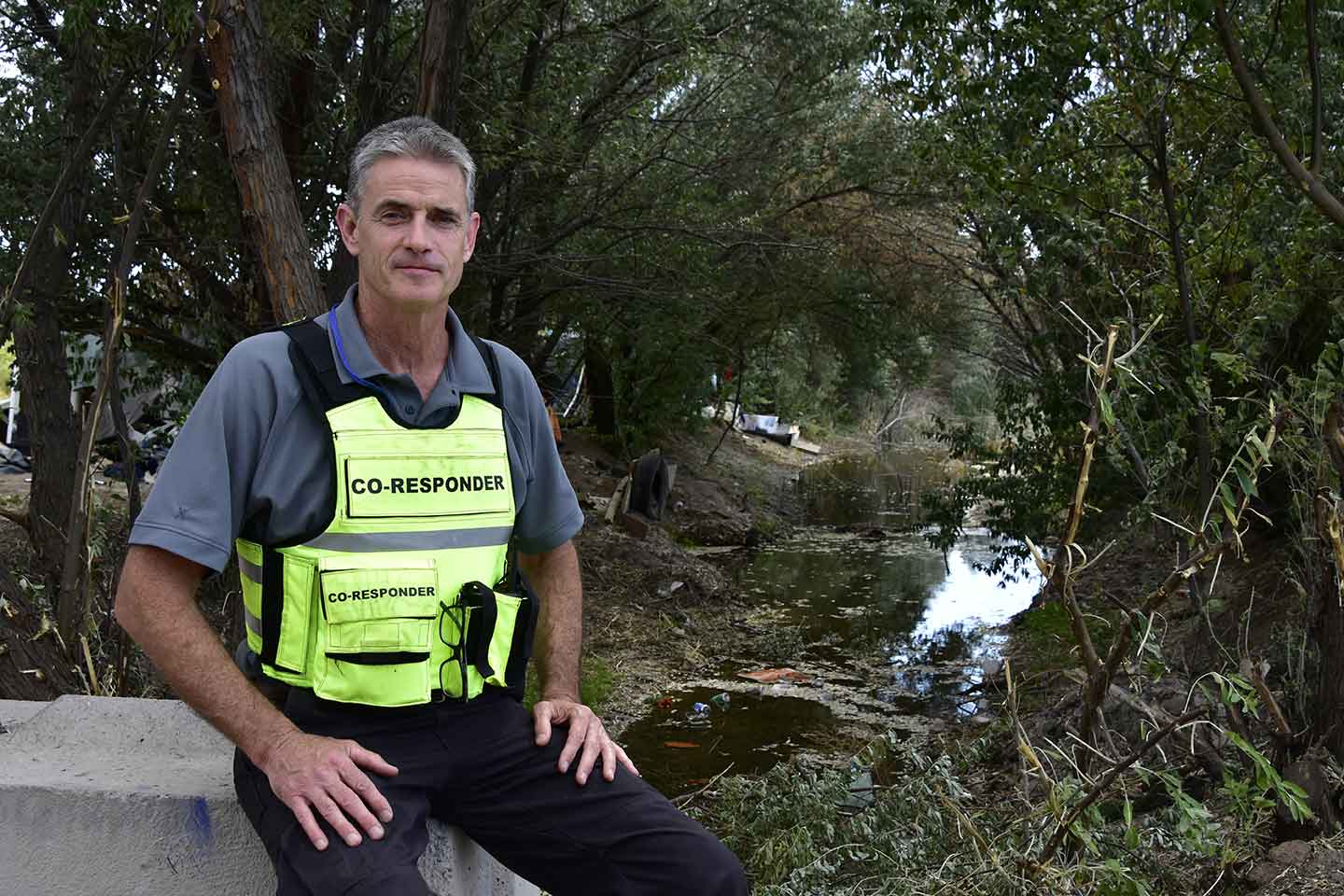
Tim Dellett was hired in 2022 as the first co-responder in Alamosa, Colo. in the San Luis Valley. “I’m just one more person in a chain of support that’s provided here in the community,” he says. Photo by John McEvoy / Special to The Colorado Trust
Beyond persistent funding issues, rural communities and regions also face additional obstacles in launching these co-responder initiatives, including large geographic areas that take time to reach; small police departments that may not be able to spare an officer for a dedicated co-responder team; and the need to cover multiple jurisdictions, each of which can have different processes and leadership, including tribal lands.
Resources like inpatient psychiatric beds or residential treatment facilities are also scarcer in these locales, so emergency rooms and staffs can become overburdened. Data from September 2022 shows that more than 2 million Coloradans live in “mental health care health professional shortage areas”; the state needs to hire more than 100 practitioners to adequately serve the population. A more recent map using federal data shows that every Colorado county is facing a shortage.
On top of that, finding skilled professionals willing to work in rural areas is generally more challenging. Finding ones willing to double as first responders is even harder.
“Do we have enough calls to have this be a program offered by our departments in rural areas? That’s something that’s continued to be looked at around the state,” says Molly Rodriguez, director of crisis services for Axis Health System, which operates 11 clinics across central and southwest Colorado. “I do think there’s a lower volume of calls in some areas that would make it really difficult to staff effectively and to have it be worthwhile.”
But there are creative ways for regions to work with what they have. The Pitkin Area Co-Responder Teams, for example, are a multijurisdictional collaboration between three law enforcement agencies (Aspen Police Department, Snowmass Village Police Department and Pitkin County Sheriff’s Office) and employs peer support specialists as part of its program. Just east, Summit County’s System-wide Mental Assessment Response Team, operated out of the sheriff’s office, incorporates a case management component.
In the spring of 2022, Montezuma County launched a grant-funded Community Intervention Program (CIP) that’s staffed with a social worker and an emergency medical technician rather than a police officer. (Law enforcement may still be present for the initial response or drive by to ensure the scene is safe for the CIP crew.) There are now two teams serving the 2,040-square-mile county, which includes Cortez, Mancos and Dolores; from January through July, they responded to 545 calls, including follow-ups.
The program has “been a godsend,” says Jim Spratlen, the county’s emergency manager and CIP’s administrative manager.
Districts can also consider telehealth options, transfer low-level calls to 988 (the national suicide and crisis hotline) to be handled over the phone or adjust their requirements for clinicians—for example, hiring bachelor’s degree-level care managers instead of master’s degree-level social workers—according to Ernest Stevens, deputy division director for behavioral health at the Council of State Governments Justice Center in New York.
These adjustments to the co-responder models can also help address some community concerns about having law enforcement respond to mental health crises at all—and worries that these programs can continue to perpetuate systemic racism in the justice system.
“Police have to be trained differently, and they have to allow the mental health professional to do what they do. It’s not about a power struggle,” says Renata Hedrington Jones, PhD, vice president of the National Association of Black Social Workers. She’s been a social worker for 50 years and used to do ride-alongs with police in Richmond, Va., in the late 1980s.
“We can’t be rigid in how we look at these programs… I’m always happy when programs are thinking outside the box and trying to do what they can to meet their community’s needs,” says Emily Anderson, a licensed clinical social worker and manager of co-responder services at Colorado’s BHA. “We’ve been very intentional in how we’ve structured the program and making sure that we don’t have some sort of purist view.”
State funding has increased alongside the growing interest in co-responder efforts. Two state bills passed last year (SB22-145 and SB22-196) made millions of dollars available via grants; additional dollars come from the Marijuana Tax Cash Fund, the State General Fund and federal programs. And just this week, the governor’s office announced an expansion to the state’s Mobile Crisis Response teams, which are dispatched in every county and have up to a two-hour response window in rural and frontier communities.
* * *
Most of the calls Matt Teague, a licensed clinical social worker with Durango’s CORE team, responds to are welfare checks, people contemplating suicide or medical issues. Having a standalone co-responder team leaves other patrol officers free to respond to criminal activity or emergencies—the jobs they signed up for. (An October 2021 report from the Colorado Health Institute, a Colorado Trust grantee, found that “co-responders reduced unnecessary law enforcement involvement in one of every three calls.”) It also means Teague’s team can spend more time with the person in need of help, both in the moment and after, potentially averting future crises.
“We built follow-up into the program. The next day, we’ll go back to the house or do a phone call,” Teague says. “There are cases where we’re limiting the number of people that would normally go through an involuntary commitment because we’re able to more effectively manage the crisis… . We try to do preventative work as well.”
Montezuma County’s CIP team has mountain bikes they’ll ride to check on people and make sure they’re aware of their presence if they do need help.
Laura, the mom in Durango, finds the CORE team to be as much a resource for her as it is for her son. The co-responders talk through her concerns with her, share resources and follow-up after any assessments. If the team is out and about and run into her son, they’ll touch base with him.
“I like that now they know him,” she says. “They’ve seen him when he’s doing great and when he’s not.”
Teague and others in similar roles may also be better connected with area resources than police officers. That helps Teague and his colleagues make appropriate referrals and build relationships between historically siloed groups, like a police department and the local food bank.
“It always seems like we were missing information as clinicians who worked in the crisis world. The implementation of these teams has created another door for people to access services, which they historically haven’t had,” says Axis Health’s Rodriguez.
Some rural towns have seen enough proof within a couple of years to want to invest even more in co-responder efforts.
Durango’s CORE team responded to more than 1,000 calls last year. The program is now an essential part of the community, with residents like Laura requesting CORE specifically when they contact dispatch. Even police officers who were initially resistant to the idea have started soliciting CORE’s help on scene, says Chief Brammer. His goal is to build a team of four officers and four clinicians.
Alamosa recently expanded its year-old program. The Alamosa Police Department hired its first co-responder clinician in August 2022; a second staffer came on board in June.
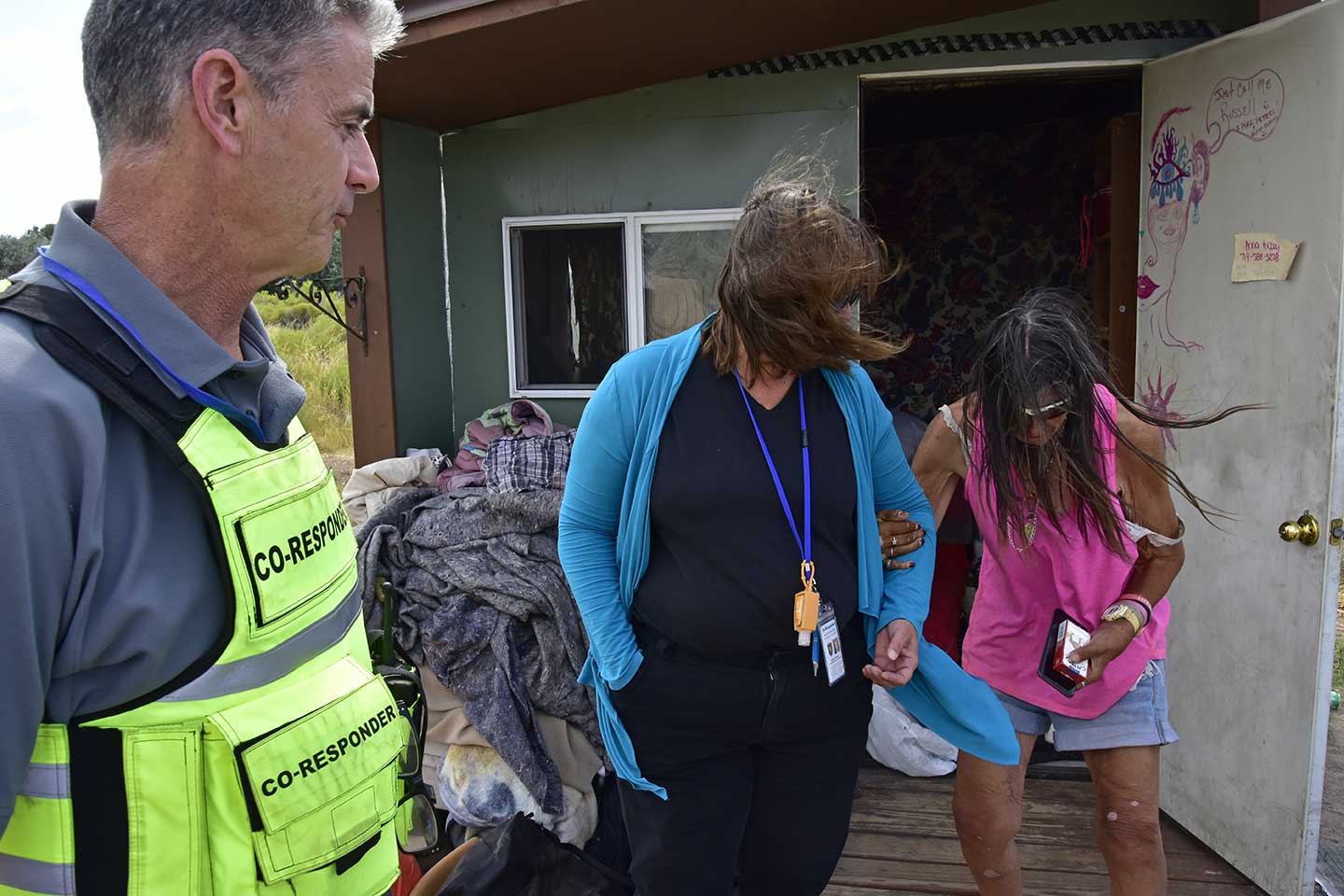
Alamosa, Colo. co-responders Tim Dellett (left) and Connie Brydges (center) assist Karen Smith (right) at the St. Benedict Campsite in Alamosa on Aug. 21, 2023. Photo by John McEvoy / Special to The Colorado Trust
“We rely on a very limited resource here in the San Luis Valley,” says Ken Anderson, the Alamosa police chief. “Having a licensed person be able to handle these things has been crucial… . It’s relieved [the patrol division from] being tied up on nonemergent situations. It’s provided the community professional treatment. It’s pushed the resources that are available to the people that need them instead of having law enforcement gamble on what are we going to do.”
Alamosa’s first clinician is Tim Dellett. He arrives on scene in an unmarked car, in plain clothes, wearing a fluorescent yellow Kevlar vest with “co-responder” written on the front and back. He’s currently working five days a week and juggling around 50 clients through a partnership with Valley-Wide Health Systems.
Among them is an area resident who was previously calling 911 upwards of 20 times a day. Those calls pulled dispatchers away from answering pleas from the rest of the valley. Now, his calls are directed straight to Dellett.
The clinician also regularly visits the city’s permanent St. Benedict Campsite for people experiencing homelessness, in order to build rapport. He hands out his cell number for nonemergent needs.
“I’m just one more person in a chain of support that’s provided here in the community,” Dellett says. “I have a different set of tools and different options.”
Dellett’s position is currently funded for three years and only covers Alamosa, not the entire San Luis Valley.
“Wouldn’t it be nice if we could cover the valley?” he says. “The need is there.”
